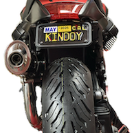To expand on it, some are scared they can't weld something that they have used brake clean on previously. That is not the case. If you use brake clean on metal and then weld it any liquid brake clean still on the metal, or even possibly some fumes that are still hanging about (although that seems like a slim issue), will break down under the heat of welding and if it is the wrong type of brake clean it will create phosgene gas. Particularly common is small traces of liquid brake clean sitting in pores of the metal. But if you use brake clean and then thoroughly dry the part you can weld it. The key is, being sure all traces of brake clean are gone. As brake clean does not leave a residue on the part, once it has evaporated it is gone, you don't need to worry about welding a part you used brake clean on previously if the brake clean is long since evaporated.
But if you only use the non-chlorinated brake clean on metal you are going to weld, or simply skip the brake clean and use other safer solvents, you don't need to worry about it. Since the possible results of welding metal that still has liquid brake clean on it are potentially lethal it makes sense to be overly cautious. I feel this is something you can't stress enough. Better safe then sorry.




